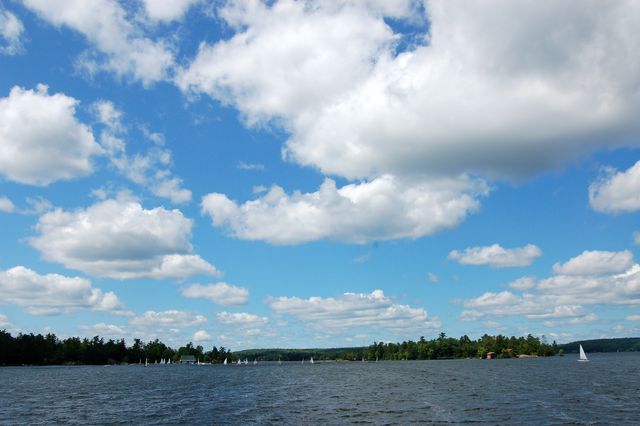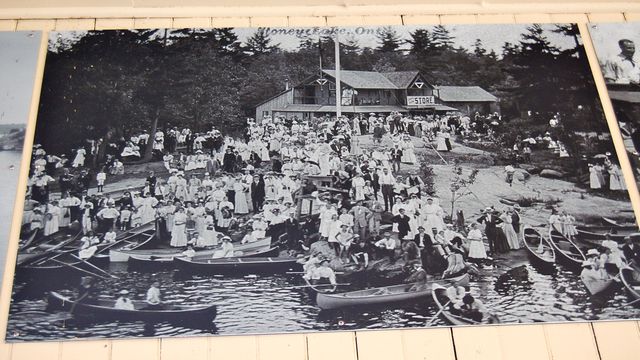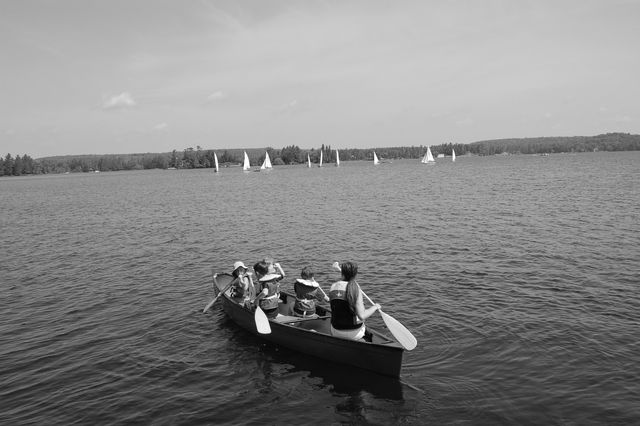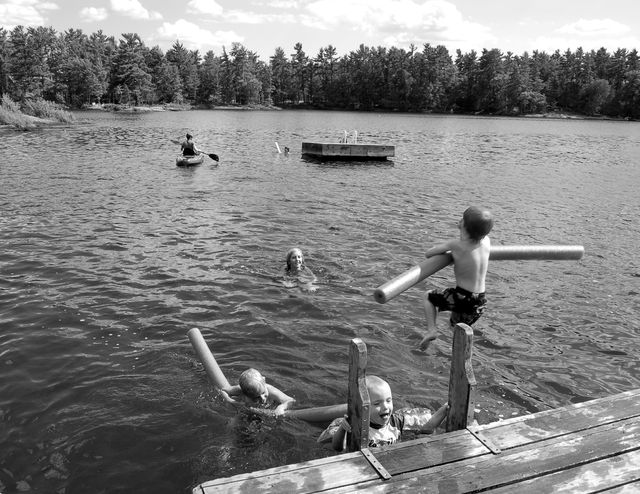
For the past three weeks, I’ve been writing these columns from my parents’ cottage in Ontario. My mother grew up on the lake, and I’ve been coming every summer since I was born. In the 60 years since my grandparents bought 10 rocky acres on Eagle Mount Island, so much in our family has changed—babies were born, learned to walk, stubbed their toes, grew up, went to college, moved away—but the lake has stayed more or less the same: It’s still the single best place on earth to be a child.
I’ve known this intuitively for as long as I can remember. I knew it when I was three and flung myself off the front dock wearing only a Styrofoam flotation bubble and when I was 13, crewing for my sister in the afternoon sailing races, and when I was 17 and spent all day whacking balls around the sun-baked tennis court during the last summer of my childhood. But knowing a place so well is a little like staring at your kids and trying to figure out who they look like, or trying to describe your own nose: The features are so familiar and dear, so specific and close to you, you see only them, not how you’re a part of them. It’s only this summer, as I'm watching my daughters do the same things I did when I was their age, that I can see Stony Lake for what it is: the place where we became adventure kids, and where we're learning to raise our own.
Two hours north of Toronto on the edge of the Canadian Shield, Stony Lake is 15 miles long and freckled with more than a thousand islands and about 800 cottages. The American Canoe Association held a regatta here in 1883, and city people began arriving via steamship in the decades that followed and building summer cottages, including our own. Some of the original families are still here. Many others are in their fourth and fifth generations, making it one of those exceedingly rare places where continuity is a way of life. There aren't many places like it left.

As lakes go, Stony isn’t as grand as Georgian Bay or as remote as Algonquin Park; you’d never call it wilderness. There are no mountains, unless you count the 100-foot-high granite knob on the north end of Eagle Mount, and the only trails are foot-stomped paths from one cottage to the next. Life here is rustic but not particularly rugged. Electricity came to our island in 1957, drinking water in 1980. We got a telephone in 1985, a dryer in 2007, Wi-Fi in 2009; TV arrived around the same time, but no one ever turns it on. There are no roads or real stores, and only one hotel. You can go for a whole week or more without getting in the car. The biggest luxury on Stony Lake is the time we get to spend here: two weeks, four weeks, some lucky ones all summer.
I used to think that for something to really count as “adventure,” you had to have risk, remoteness, or extreme terrain. You had to sleep outside on hard ground or portage a canoe for days on end or climb really big mountains. You had to suffer and get dirty. But when you’re a kid, the only things you really need are fresh air and freedom.

Growing up, my siblings and I didn’t know how good we had it. How could we? It was all we knew. Each summer, we arrived in early July and spent the month running more or less feral around the lake. We lived in bathing suits and rarely wore shoes. We learned to swim, paddle canoes, row a skiff, and sail. We learned how to read the sky to know when a storm was coming, and the water to know where the wind was coming from, and how to catch grasshoppers and fish and dive off the splintery wooden diving board. We built crude sailboats out of scrap lumber, sticks, and pieces of old sheets, and launched them from tiny harbors in the rocks. When we got older we swam the rapids at Burleigh Falls and paddled Eel's Creek and camped on a deserted island off the point. We lived with our parents but only saw them in passing, at meals or bedtime or when we needed money, which was seldom (you could charge licorice or hamburgers to your parents’ bill at the Juniper Island Store; beyond that, there was little else to want, or buy). It was like our own summer camp, only we were home.
I was 11 when I learned to drive our old cedar strip runabout with an ancient 5.5-horsepower engine. With it came the freedom to ferry myself around the lake, to sailing and tennis lessons on Juniper Island, hub of all activity, to friends’ cottages to swim, to Friday night movies shown on an old projector in a hundred-year-old cottagers’ pavilion. Later, as teenagers, we gave no thought to crossing the lake on the blackest of nights, navigating around its namesack rocks and unmarked shoals with only a flashlight. Little by little, we were making the water our own. It was like getting a bicycle—now that we had the means to explore it, the lake cracked open with possibilities.
Of course there were rules, expectations. Sailing lessons started promptly at 9. When a storm came, no matter where you were, you had to get off the water. Little ones must wear lifejackets outside at all times, no exceptions. Wednesday nights were for square dancing, $2 at the door. If you wanted to get a popsicle at the store, you had to do your swim lesson, even if it was windy and cold. There was an elaborate, rotating chore chart tacked to our dining room wall: set the table, clear the table, sweep the floor, rinse and dry. And on days when your parents went to town for groceries, you’d catch hell if you weren’t on the dock to help carry up boxes when they got back.

The French have a name for this style of parenting: “cadre,” freedom within structure. We were raised this way on the lake because our parents were raised this way, too, and maybe even their parents before them. And our friends and their parents. It’s easier to send your child across the lake in a wobbly wooden boat when the lake is full of other such boats and other such kids, and you know that people you’ve known for decades are watching out for them. We knew the rules would keep us safe, so we followed them, and were set free.
This might sound quaint if it weren’t still this way, almost exactly as it was nearly 40 years ago. Watching my four-year-old roam barefoot around the island in her lifejacket and my two-year-old jump off the dock for the first time and taking them both sailing with their grandmother, I feel enormously grateful. The lake's familiar rythmn holds them the way it held us: morning swim lessons, paddling around the island, dinner on the screened-in porch, square dancing on Wednesday nights, sticky peach-eating on the lawn, and swimming at all hours.
Stony Lake is in their blood now, too, and for a month each summer they can live free, outside, in the sun and the water, in a 120-year-old wooden cottage that has seen four generations of their family run across its creaky floors, with friends I hope they’ll have their whole life. This is the way childhood, and summer, is meant to be.
 —Katie ArnoldÂ